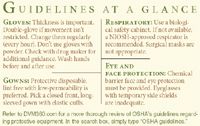Hazardous therapy
NATIONAL REPORT - Brett Cordes, DVM, turned 35 when he felt the lump in his neck.
NATIONAL REPORT — Brett Cordes, DVM, turned 35 when he felt the lump in his neck.
"The first question the human endocrinologist asked me was, 'Do you handle chemotherapy drugs?' My initial instinct was to panic. Then I said, 'yes.'"

Photo: Mark Peterrman
Now 37, the small-animal practitioner markets safety systems designed to help protect health-care workers from exposure to chemotherapy drugs — human carcinogens known to cause secondary cancers in some patients. It's an issue he's passionate about because, like a growing number of his colleagues, Cordes (photo) links his battle with Hurthle cell carcinoma to years of chemotherapy exposure as he treated his oncology patients.
"I remember dumping drugs down the drain and handling them with the same gloves I used to treat anal glands," he says. "I'm healthy now, but whether or not there was an association between the drugs and my disease, I'll never know. It bothered me enough to quit my job, and I can guarantee that more veterinarians are going to get diseased and eventually get sued by the technicians who handle these agents."
If Cordes' prediction sounds extreme, it's one that appears to have captured the American Veterinary Medical Association's (AVMA) attention. At press time, the group's Council on Veterinary Service met to explore the safe handling of chemotherapeutic agents for its five-year review of the national association's policy on workplace hazards.
While AVMA officials refused to detail what prompted such action, the move follows alerts like the federal government's 2004 warning to 5.5 million American health-care workers, stating that the powerful drugs used in chemotherapy can themselves cause cancer and pose health risks to the nurses, pharmacists and veterinary-care workers who manage them.

Guidelines at a glance
"It seems counter-intuitive that the health-care industry, whose mission is the care of the sick, is itself a high-hazard industry for the workers it employs," the Centers for Disease Control and Prevention (CDC) statement says.
Yet with minute numbers handling such drugs off-label, federal agencies often overlook the role veterinary medicine plays in chemotherapy administration. Attention to safe-handling practices is an issue that's late to evolve in human medicine and even more sluggish for veterinary practices.
The reason? An estimated 20 percent of all veterinary hospitals use chemotherapy agents, which translates to a tiny market in comparison to the human sector. What's more, agencies like the Occupational Safety and Health Administration (OSHA) might have handling guidelines, but they're vague, and enforcement takes place only on a complaint-driven basis, critics contend.
OSHA representatives did not return DVM Newsmagazine's interview requests.
"There are no real regulations," oncology specialist Dr. Greg Ogilvie says, "but you put a gun to someone's head and ask them how many die from chemo-therapy exposure, and that number does not exist, either. I'm not a fan of government regulations. Look at the EPA (Environmental Protection Agency) or OSHA — they don't have a big enough enforcement branch to clean up horrible things down the street, let alone go into every veterinary practice."
Instead, Ogilvie pushes the need for safety education that empowers veterinarians to do their jobs better. To do it right, he estimates a veterinary practice must spend $50,000 to $100,000 in fixed costs, plus up to $20 per patient for disposable products to put the proper safety protocols in place. It's a price tag that's out of reach for many general practices, he admits.
Legal exposure
Still, despite the financial hurdle and lack of official oversight, veterinarians' handling practices have evolved, in many cases, to include impermeable gowns, gloves and biological safety cabinets. Still, safety measures need to go much further, experts contend.
Four years after the CDC's warning, human medicine faces lawsuits linking workers' exposure to diseases spanning everything from reproductive abnormalities and hearing loss to skin irritation and breast cancer. Although science still lacks hard evidence showing a connection between chemotherapy exposure and disease in occupational handlers, veterinary experts liken the profession's ham-fisted approach to safety to where the profession was nearly 15 years ago on radiation, when associations between exposure and cancer emerged to force regulations.
"These drugs cause DNA disruption, and in comparison to radiation, chemotherapy exposure has proven just as deadly," says Dr. G.G. Davidson, who claims the discovery of precancerous lesions on her bladder prompted the veterinarian pharmacist to crack down on her once "cavalier" approach to chemotherapy drug handling.
"It's a huge liability issue. If someone has a miscarriage in a veterinary practice, the owner will be hard-pressed to prove that he didn't contribute to that."
Dr. James F. Wilson agrees, although the lawyer and veterinarian consultant maintains that such legal battling could "be very costly and go on forever."
"I don't think any insurance would cover a practice owner in a case like this," he contends. "It might be immensely hard to prove an approximate cause of the illness, but such a lawsuit would likely expose a practice owner to financial hardship. It would certainly cost a lot to deal with this."
Research
Thomas O'Connor, a scientist with the CDC's National Institute of Occupational Safety & Health (NIOSH) says that while there's no strong evidence concerning occupational exposures, a soon-to-be-published study he conducted looked at workplace contamination in three human hospitals. The result: Half a dozen drugs were picked up in the urine of workers, including chemotherapy agents. Wipe samples and air samples revealed that pharmacy and patient areas were highly contaminated, posing dermal exposure risks to everyone encountering them.
O'Connor, who has researched chemotherapy drugs and the effects of such human carcinogens for 25 years, imagines that contamination in veterinary practices might prove much worse.
"Despite the safety protocols, these drugs were everywhere, on the counters and on the floors," he says. "In veterinary practices, I wouldn't guess that you wouldn't even have that level of safety, especially because technicians are mixing the same drugs that pharmacies handle for human hospitals. You also have animals urinating, and a lot of these drugs coming out in the urine. There's a real danger to people who want to be with their animals while they're being treated. It's got to be a fairly hazardous situation."
Safeguards
Yet veterinarians like Ogilvie downplay contamination risks when the right protocols are put in place. He considers it a mistake to focus only on drugs used to treat oncology cases and not the safe handling of all hazardous agents.
"I've never seen anyone get sick from dealing with chemotherapy," he says. "But I do know of a veterinarian who died from developing a severe allergy to penicillin after repeatedly handling it. There have been many drugs that have been misused for ages, not by willful neglect, but by ignorance. We have an amazing profession that wants to help patients and clients. Regulations are only as good as their enforcement. The greatest weapon that veterinary medicine has is education."
That's Wendy Minor's contention, as the registered veterinary technician heads to Seattle this month to speak at the Veterinary Technician Cancer Society's annual meeting on the safe handling of chemotherapy agents.
"In the human field, you have to be in a pressurized room. Who's going to be able to afford that in veterinary medicine?" she asks. "More than half of your veterinary hospitals that are mixing these drugs don't even have a safety hood. When I see people like my sister, who's pretty sick from all the chemo she's been administering, I just want to educate people the right way about this."
Board-certified oncologist Dr. Sue Downing, of the Veterinary Cancer Group of Los Angeles, enforces a handling training program that can take more than a year for technicians to complete. Staff members learn about the drugs, restraint and injection techniques as well as calculations before they ever draw a medication. The next step is diluting and preparing drugs for administration, starting with those that have the lowest safety risk.
"Anyone with a veterinary degree can order these drugs, and any unlicensed veterinary technician can administer them under the order of a DVM." she says. "I think some of the scariest stories come from practices where there aren't many safety protocols in place, because we all have accidents. There have been well-documented cases where an animal coming into contact with these drugs has resulted in amputation of a limb. That's why we have antidotes for some of these more aggressive chemicals right on the shelf. Human error is something you can't get away from entirely."
USP 797
Downing predicts that any change in the law to mandate and enforce safeguards would have to come through state boards or federal legislation. But Cordes, the veterinarian who beat thyroid cancer, says a strict law that governs pharmacists also applies to veterinarians.
It's called USP 797. The guidelines (www.usp.org/products/797Guidebook/), developed by U.S. Pharmacopeoia and revised last year, sets the nation's first standards for sterile and safe pharmaceutical compounding and, by definition, that includes drawing chemotherapy drugs from a vial. While it's meant to govern pharmacists, veterinarians mixing chemotherapy drugs also fall under these standards, he says, which are enforceable by state pharmacy boards in at least a dozen states and the Food and Drug Administration.
"797 applies to anybody handling chemotherapy, period," Cordes contends. "We fall through the cracks because we're so small; human oncology is 500 times larger. But these guidelines mandate certain behaviors when handling and mixing chemotherapy drugs. Veterinarians just don't realize they're subject to the same standards of practice as pharmacists when they're doing stuff like this."
Sections of 797 call for the installation of clean rooms, biological safety cabinets and non-shedding coats and gowns to be applied in a "gowning sequence," to name a few of its stipulations. Veterinary pharmacist Davidson says that while this is on the human and pharmacy radar, that's not the case for veterinary medicine.
"There is no veterinary practice exemption in this law, so if FDA starts enforcing it, veterinarians will be in for a rude awakening," she predicts. "Of course, there will have to be some human harm proven before FDA does anything. Right now, I don't think many veterinarians think the risks are real, but there are going to be some lawsuits, because there are going to be more Brett Cordes out there."
Fiala is a freelance writer based in Cleveland. She spent eight years with DVM Newsmagazine as senior editor and now also works with the Veterinary Information Network.